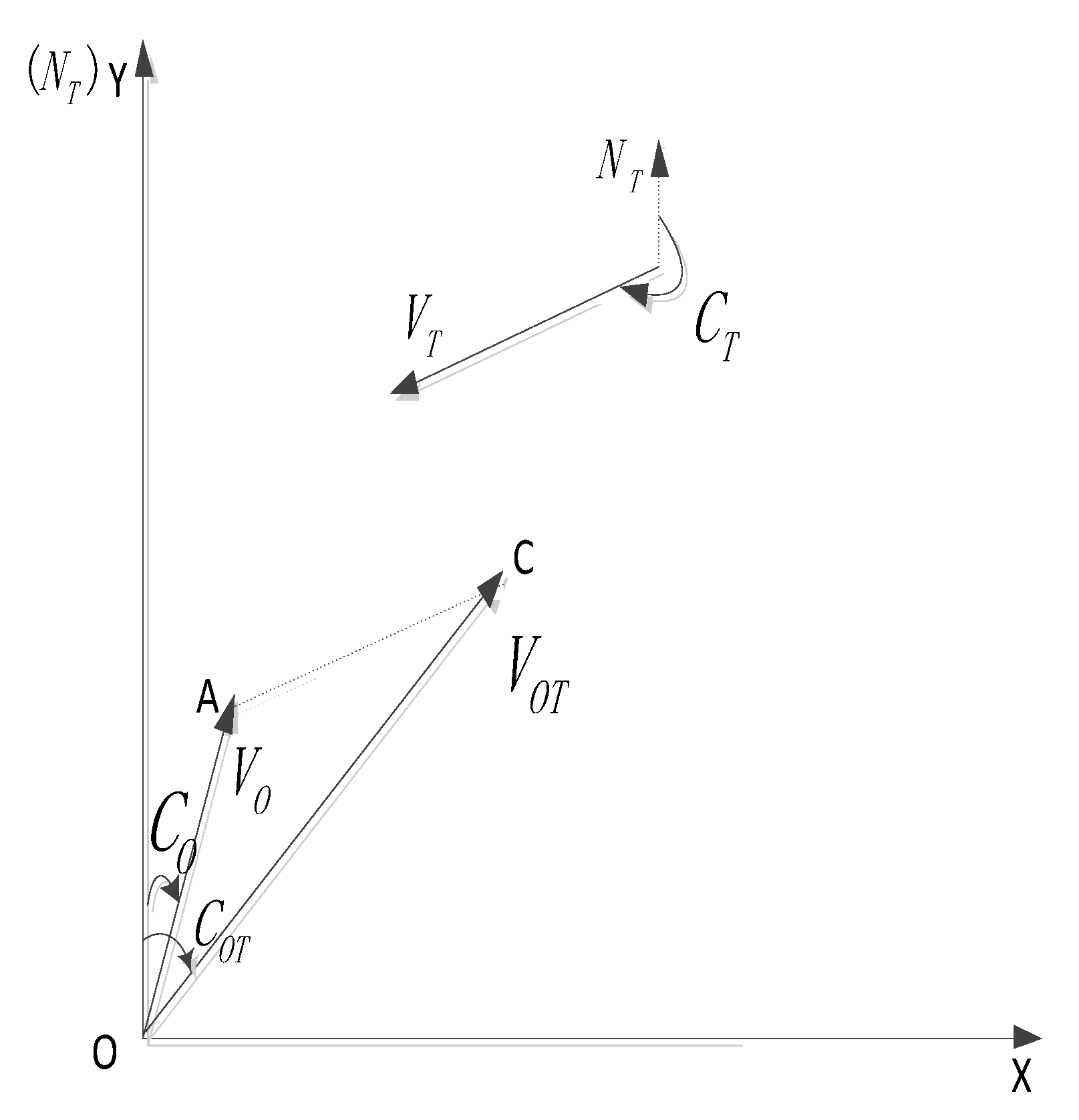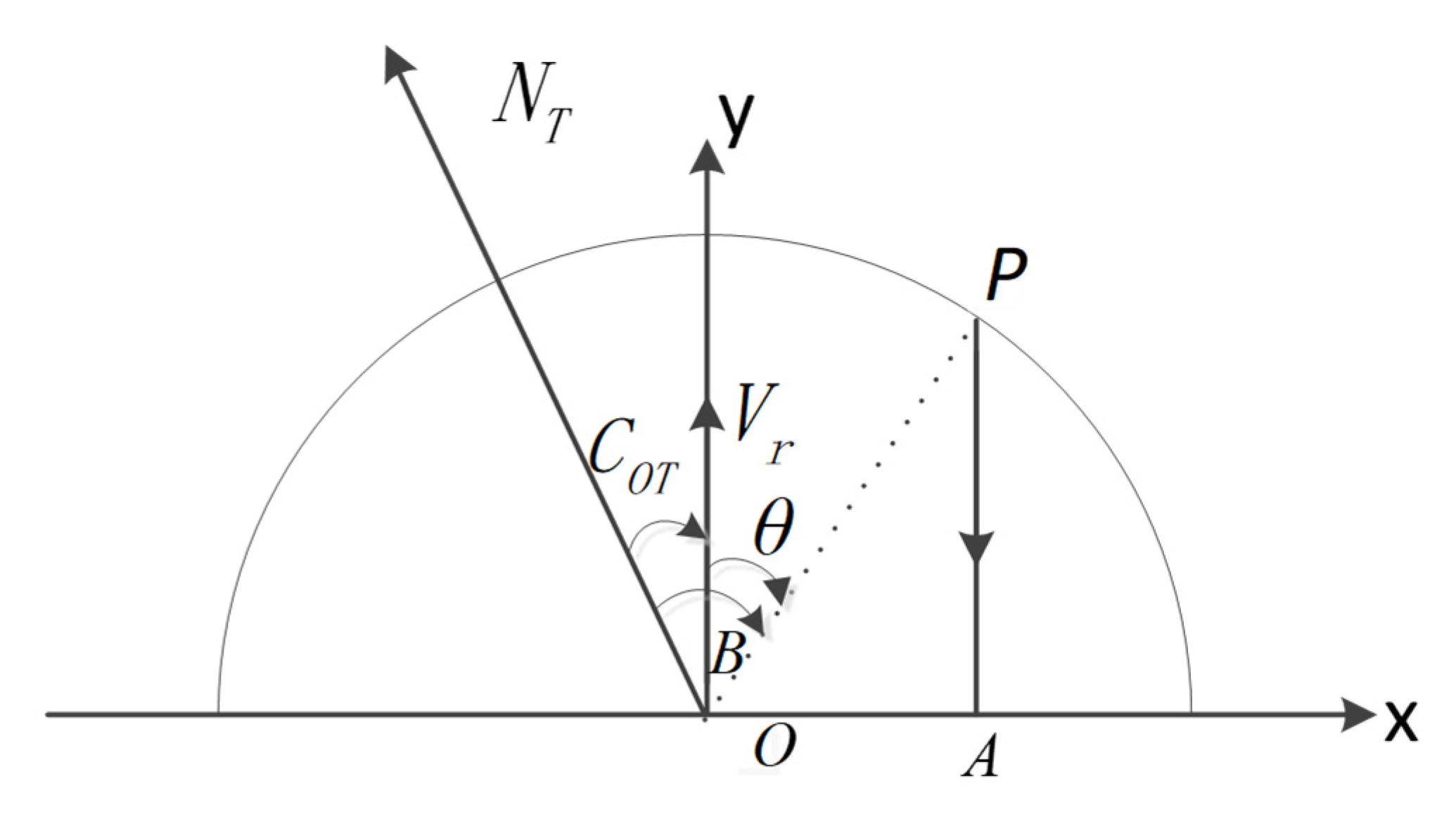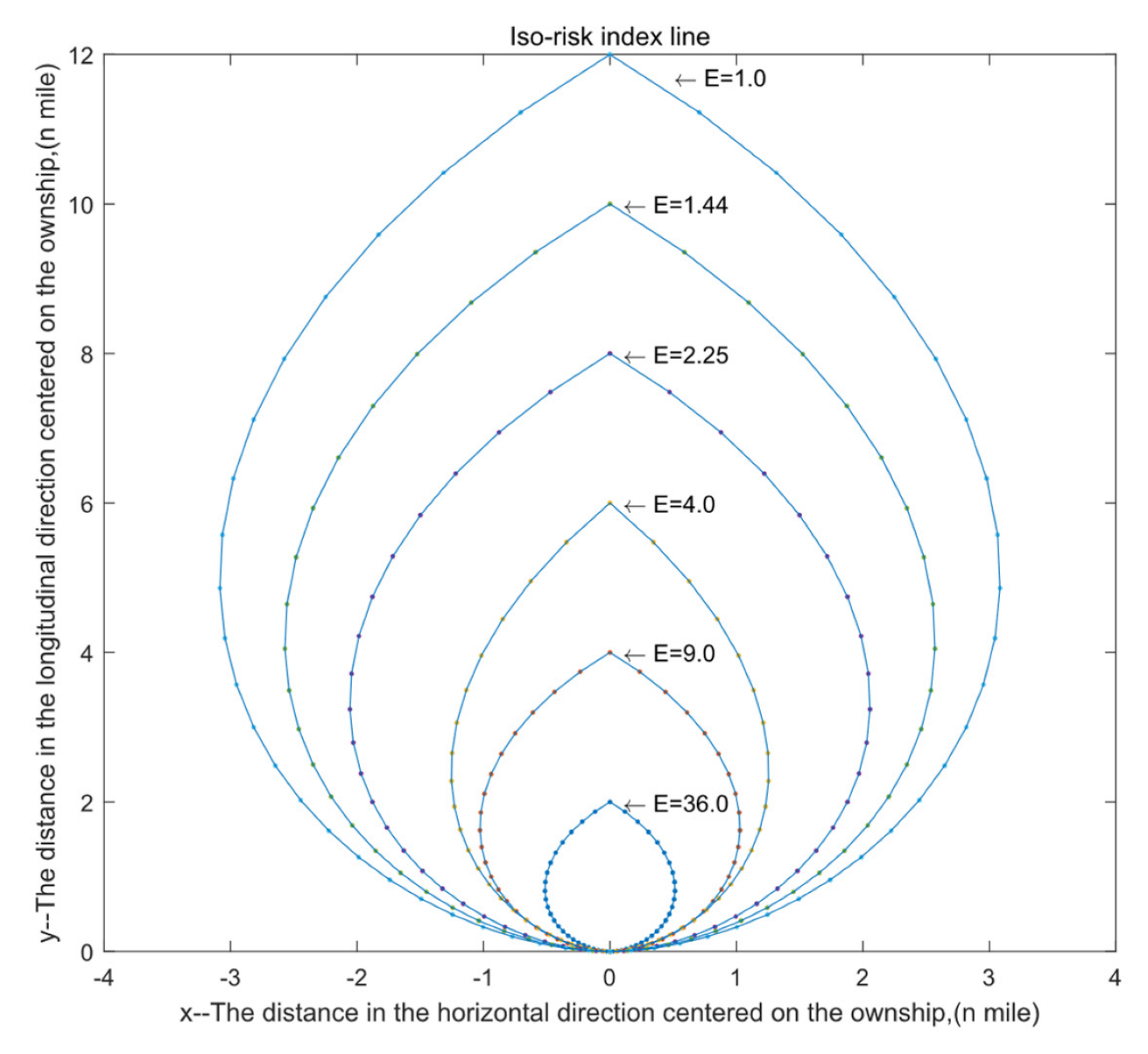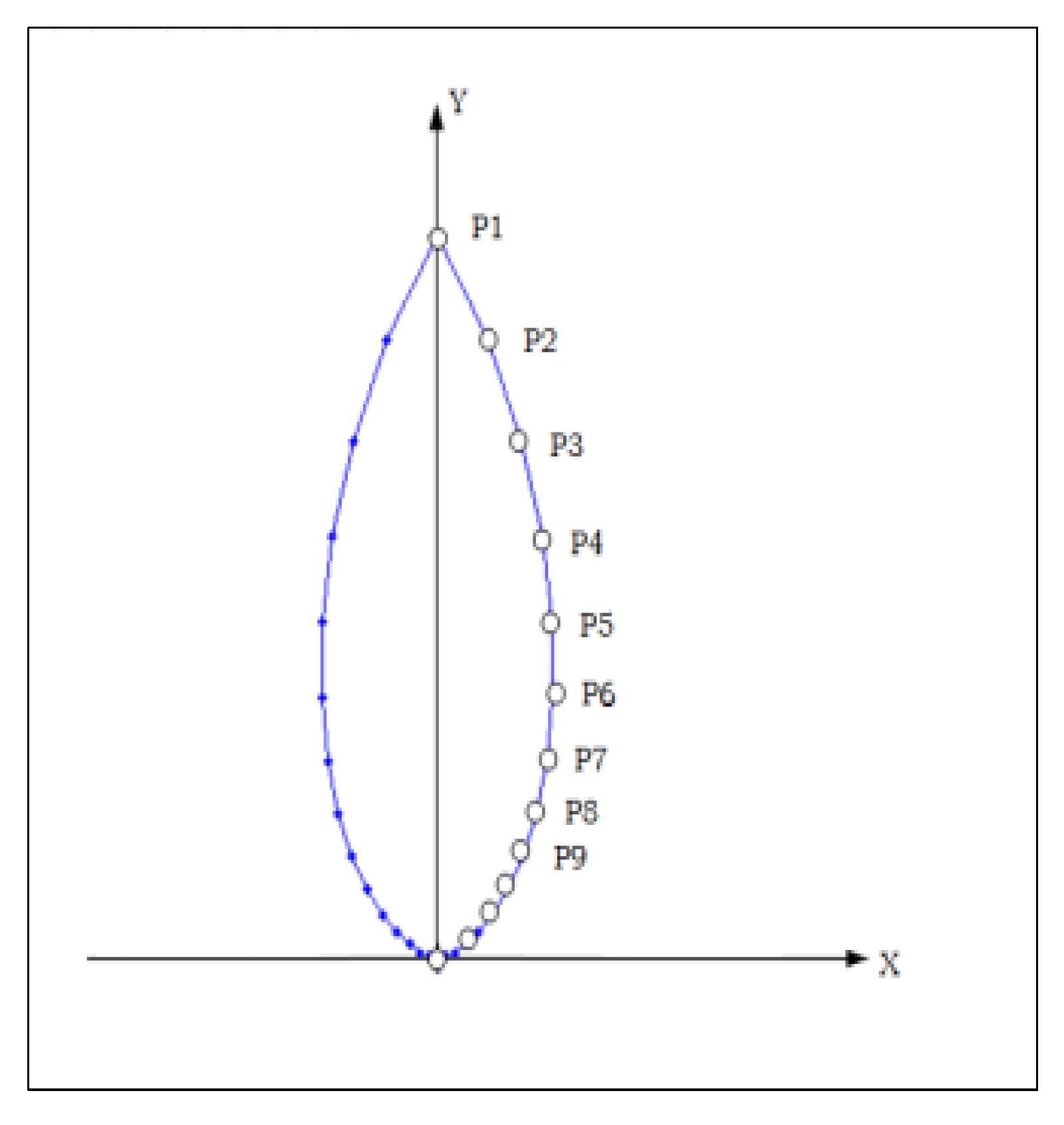Critical Collision Risk Index Based on the Field Theory
Abstract
:1. Introduction
2. Materials and Methods
2.1. Relative Speed and Course
2.2. Collision-Risk Field
2.2.1. Conceptual Proposal of Collision-Risk Field
2.2.2. Improvement of Collision-Risk Field Formula
2.2.3. Real Collision-Risk Index
2.2.4. Isorisk Index Line
3. Results
4. Discussion
5. Conclusions
Author Contributions
Funding
Institutional Review Board Statement
Informed Consent Statement
Data Availability Statement
Conflicts of Interest
References
- Chen, P.; Huang, Y.; Mou, J.; van Gelder, P. Probabilistic risk analysis for ship-ship collision: State-of-the-art. Saf. Sci. 2019, 117, 108–122. [Google Scholar] [CrossRef]
- Montewka, J.; Hinz, T.; Kujala, P.; Matusiak, J. Probability modelling of vessel collisions. Reliab. Eng. Syst. Saf. 2010, 95, 573–589. [Google Scholar] [CrossRef]
- Fujii, Y.; Yamanouchi, H.; Mizuki, N. On the fundamentals of marine traffic control. Part 1 probabili-ties of collision and evasive actions. Electron. Navig. Res. Inst. Pap. 1970, 2, 1–16. [Google Scholar]
- Macduff, T. The probability of vessel collisions. Ocean. Ind. 1974, 9, 144–148. [Google Scholar]
- Shah, B.C.; Švec, P.; Bertaska, I.R.; Sinisterra, A.J.; Klinger, W.; von Ellenrieder, K.; Dhanak, M.; Gupta, S.K. Resolution-adaptive risk-aware trajectory planning for surface vehicles operating in congested civilian traffic. Auton. Robot. 2015, 40, 1139–1163. [Google Scholar] [CrossRef]
- Ren, J.; Jenkinson, I.; Wang, J.; Xu, D.; Yang, J. A methodology to model causal relationships on offshore safety assessment focusing on human and organizational factors. J. Saf. Res. 2008, 39, 87–100. [Google Scholar] [CrossRef]
- Uğurlu, Ö.; Köse, E.; Yıldırım, U.; Yüksekyıldız, E. Marine accident analysis for collision and grounding in oil tanker using FTA method. Marit. Policy Manag. 2015, 42, 163–185. [Google Scholar] [CrossRef]
- Montewka, J.; Ehlers, S.; Goerlandt, F.; Hinz, T.; Tabri, K.; Kujala, P. A framework for risk assessment for maritime transportation systems—A case study for open sea collisions involving RoPax vessels. Reliab. Eng. Syst. Saf. 2014, 124, 142–157. [Google Scholar] [CrossRef]
- Goodwin, E.M. A Statistical Study of Ship Domains. J. Navig. 1975, 28, 328–344. [Google Scholar] [CrossRef] [Green Version]
- Rawson, A.; Rogers, E.; Foster, D.; Phillips, D. Practical Application of Domain Analysis: Port of London Case Study. J. Navig. 2014, 67, 193–209. [Google Scholar] [CrossRef]
- Szlapczynski, R.; Szlapczynska, J. Review of ship safety domains: Models and applications. Ocean Eng. 2017, 145, 277–289. [Google Scholar] [CrossRef]
- Goerlandt, F.; Kujala, P. On the reliability and validity of ship–ship collision risk analysis in light of different perspectives on risk. Saf. Sci. 2014, 62, 348–365. [Google Scholar] [CrossRef]
- Zhang, J.; Yan, X.; Chen, X.; Sang, L.; Zhang, D. A novel approach for assistance with anti-collision decision making based on the International Regulations for Preventing Collisions at Sea. Proc. Inst. Mech. Eng. Part M J. Eng. Marit. Environ. 2012, 226, 250–259. [Google Scholar] [CrossRef]
- Wang, X.; Liu, Z.; Cai, Y. The ship maneuverability based collision avoidance dynamic support system in close-quarters situation. Ocean Eng. 2017, 146, 486–497. [Google Scholar] [CrossRef]
- Bukhari, A.C.; Tusseyeva, I.; Lee, B.-G.; Kim, Y.-G. An intelligent real-time multi-vessel collision risk assessment system from VTS view point based on fuzzy inference system. Expert Syst. Appl. 2013, 40, 1220–1230. [Google Scholar] [CrossRef]
- Lisowski, J. Game Control of Moving Objects. IFAC Proc. Vol. 2002, 35, 373–378. [Google Scholar] [CrossRef] [Green Version]
- Mou, J.M.; van der Tak, C.; Ligteringen, H. Study on collision avoidance in busy waterways by using AIS data. Ocean Eng. 2010, 37, 483–490. [Google Scholar] [CrossRef]
- Degré, T.; Lefèvre, X. A Collision Avoidance System. J. Navig. 1981, 34, 294–302. [Google Scholar] [CrossRef] [Green Version]
- Lenart, A.S. Collision Threat Parameters for a new Radar Display and Plot Technique. J. Navig. 1983, 36, 404–410. [Google Scholar] [CrossRef]
- Chen, P.; Huang, Y.; Mou, J.; van Gelder, P. Ship collision candidate detection method: A velocity obstacle approach. Ocean Eng. 2018, 170, 186–198. [Google Scholar] [CrossRef]
- Szlapczynski, R.; Szlapczynska, J. An analysis of domain-based ship collision risk parameters. Ocean Eng. 2016, 126, 47–56. [Google Scholar] [CrossRef]
- Huang, Y.; Chen, L.; van Gelder, P.H.A.J.M. Generalized velocity obstacle algorithm for preventing ship collisions at sea. Ocean Eng. 2019, 173, 142–156. [Google Scholar] [CrossRef]
- Zhang, W.; Wei, S.; Teng, Y.; Zhang, J.; Wang, X.; Yan, Z. Dynamic Obstacle Avoidance for Unmanned Underwater Vehicles Based on an Improved Velocity Obstacle Method. Sensors 2017, 17, 2742. [Google Scholar] [CrossRef] [PubMed] [Green Version]
- Huang, Y.; Chen, L.; Chen, P.; Negenborn, R.R.; van Gelder, P.H.A.J.M. Ship collision avoidance methods: State-of-the-art. Saf. Sci. 2020, 121, 451–473. [Google Scholar] [CrossRef]
- Khatib, O. Real-Time Obstacle Avoidance for Manipulators and Mobile Robots. In Autonomous Robot Vehicles; Cox, I.J., Wilfong, G.T., Eds.; Springer: New York, NY, USA, 1990; pp. 396–404. [Google Scholar] [CrossRef]
- Lyu, H.; Yin, Y. COLREGS-Constrained Real-time Path Planning for Autonomous Ships Using Modified Artificial Potential Fields. J. Navig. 2018, 72, 588–608. [Google Scholar] [CrossRef]






| Field | Factor 1 | Factor 2 | Formula |
|---|---|---|---|
| Gravitational field | Star mass (m) | Distance between any point and the center of the star (r) | |
| Collision-risk field | Relative speed (Vr2) | Distance between any point and the center of OS (r) |
| Target Ship | Speed /kn | Course /Degree | Distance/ n Mile | Bearing (B) /Degree | Relative Speed (VOT)/kn | Relative Course (COT)/Degree |
|---|---|---|---|---|---|---|
| T1 | 17 | 240 | 6 | 030 | 29.4 | 030 |
| T2 | 8 | 285.5 | 11 | 067 | 16.7 | 030.4 |
| T3 | 20 | 328 | 8 | 090 | 10.6 | 089.8 |
| T4 | 20 | 000 | 5 | 175 | 3.0 | 180 |
| T5 | 22 | 030.5 | 7 | 260 | 11.3 | 260 |
| T6 | 17 | 080 | 10 | 315 | 21.9 | 310 |
| Target Ship | DCPA /n Mile | TCPA /min | E | RTCPA /min |
|---|---|---|---|---|
| T1 | 0.0 | 12.2 | 24.0 | 12.2 |
| T2 | 7.0 | 30.4 | 0.42 | 93.2 |
| T3 | 0.0 | 45.3 | 1.7 | 45.4 |
| T4 | 0.4 | 99.6 | 0.41 | 92.0 |
| T5 | 0.0 | 37.1 | 2.6 | 37.2 |
| T6 | 0.9 | 27.3 | 4.0 | 30.0 |
Publisher’s Note: MDPI stays neutral with regard to jurisdictional claims in published maps and institutional affiliations. |
© 2022 by the authors. Licensee MDPI, Basel, Switzerland. This article is an open access article distributed under the terms and conditions of the Creative Commons Attribution (CC BY) license (https://creativecommons.org/licenses/by/4.0/).
Share and Cite
Ma, W.; Wang, H.; Wang, S. Critical Collision Risk Index Based on the Field Theory. J. Mar. Sci. Eng. 2022, 10, 1748. https://doi.org/10.3390/jmse10111748
Ma W, Wang H, Wang S. Critical Collision Risk Index Based on the Field Theory. Journal of Marine Science and Engineering. 2022; 10(11):1748. https://doi.org/10.3390/jmse10111748
Chicago/Turabian StyleMa, Wenyao, Hongbo Wang, and Shengyin Wang. 2022. "Critical Collision Risk Index Based on the Field Theory" Journal of Marine Science and Engineering 10, no. 11: 1748. https://doi.org/10.3390/jmse10111748
APA StyleMa, W., Wang, H., & Wang, S. (2022). Critical Collision Risk Index Based on the Field Theory. Journal of Marine Science and Engineering, 10(11), 1748. https://doi.org/10.3390/jmse10111748






